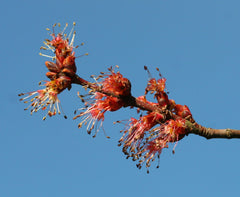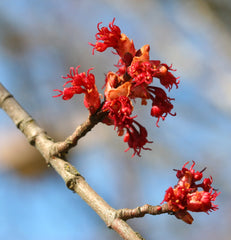See the blooming trees! April 09 2018, 0 Comments
Many people are surprised to learn that broadleaf trees are flowering plants. It is true that most of them do not have the showy blossoms that people associate with the word “flower.” Members of the rose and magnolia families aren’t subtle with their flowers. Any sighted person can tell they are blooming.
Other kinds of trees may have quite inconspicuous flowers. The blooms may be so subtle that most people, including children, do not notice them. Help your children see these structures as they happen briefly in spring.
The red maples are among the first to bloom. Maples have a variety of flower structures and reproductive strategies. Some have yellow-green flower clusters that have both staminate and pistillate flowers. Others make extra staminate flowers and only a few with pistils.
Red maples are mostly dioecious – they have staminate and pistillate flowers on separate trees. I say “mostly” because I have seen and read other reports that a tree of one sex will sometimes have one branch that has the opposite sex flowers. This probably helps insure that pistillate flowers will receive the pollen they need to make seeds.
When the red maple starts to bloom, you may notice a red tint on the branch tips. If you can find a branch that is low enough for you to examine (try binoculars if the branches are too high), you will find one of two types of flowers. Neither has petals; both are small. The pistillate flowers (left) have two-branched stigmas showing. They are more intensely red than the staminate flowers (right), which look like a tiny pom-pom in reddish pink.

After the flowers bloom, the staminate flowers fall off. They have released their pollen, and their work is done. The pistillate flowers that received pollen continue to grow, and they develop long stalks with their young fruits at the end, often still bearing the drying stigmas. The fruits will become the maple keys; two grow joined together, but they split at maturity. This makes a maple fruit a schizocarp. Its two sections are samaras, winged fruits that the wind disperses.
Elms are another family of early bloomers. Their flowers are tiny, just two little furry stigmas surrounded by stamens. The developing fruits – again they are samaras – often color the tree a spring green and then turn brown before the leaves are completely unfurle d.
d.
Ask your children to think about the adaptation of blooming early, having wind-pollinated flowers, and having wind-dispersed fruits. They may be able to reason that the trees must bloom early so that their leaves won’t interfere with the pollen transfer. Some trees, like the elms, even disperse their seeds before the leaves block the wind from the mature fruits.
Swelling buds and developing leaves and shoots make great subjects for botany observation. Enjoy them with your children as the shoots and the spring develop.
Priscilla, April 9, 2018

